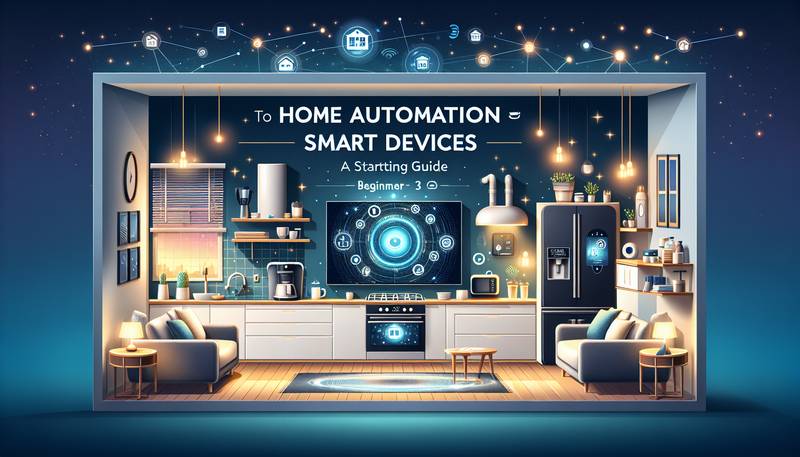Introduction to Home Automation and Smart Devices: A Starting Guide

Welcome to the World of Smart Living
Welcome to the future of living, where technology and convenience meet to create homes that are more responsive, efficient, and tailored to your lifestyle. Home automation and smart devices have been gaining popularity over the last few years and for good reason. They allow you to control your home environment with the touch of a button or a simple voice command. Imagine waking up in the morning to a house that has already adjusted the temperature to your comfort level, opened the blinds to let in the morning sun, and started brewing your coffee – all without lifting a finger. That's the magic of a smart home. In this guide, we'll take you through the basics of home automation, the devices you can use to start your journey, how to set them up, and what to look for as you expand your smart home system. Whether you’re tech-savvy or new to the world of smart technology, this guide will provide you with all the information you need to begin transforming your house into a smart home.
The Basics: What is Home Automation?
Home automation is essentially the ability to control various systems and appliances within your home remotely or through a centralized device. This can include lighting, heating, air conditioning, security systems, and even kitchen appliances. Automation can be as simple as setting a schedule for your lights to turn on and off or as complex as a network of devices that communicate with each other to create a completely automated home environment. The core idea behind home automation is to make everyday tasks simpler and to improve the efficiency of your home, potentially even reducing energy costs. By using sensors, smart devices can detect changes in the environment – such as a drop in temperature – and respond accordingly, such as turning on the heat without you having to do anything. It's about creating a home that knows what you want and works to make sure you have it.
Starting with Smart Devices
Wouldn't it be great if your house knew just how much sugar you take with your coffee or could blast your favorite song to wake you up in the morning? Well, smart devices are the stepping stones to achieving that sentient home. They are the individual components that connect to your home network and can be controlled via your mobile devices or a central hub. Some of the most common smart devices include the following:
- Smart Thermostats: Devices like the Nest or Ecobee learn your temperature preferences over time and adjust themselves accordingly. They can turn the heat down when you leave for work and get things cozy by the time you get back.
- Smart Lights: Products like Philips Hue and LIFX bulbs allow you to control the lighting in your home remotely. Change colors, set timers, and even create lighting "scenes" for different activities throughout the day.
- Smart Locks: With brands like August and Yale, you can lock and unlock your doors from anywhere, grant temporary access to guests, and get notifications whenever someone enters your home.
- Smart Cameras: Security devices like the Ring or Arlo cameras give you the ability to monitor your home in real time, get alerts on activity, and even communicate with visitors via two-way audio.
These devices connect to your home Wi-Fi network and can often be controlled through dedicated apps on your smartphone. This allows you to manage your home from anywhere in the world, as long as you have an internet connection. The key to successful smart device implementation is choosing products that are compatible with one another and with any other home automation systems you may want to integrate in the future.
Creating a Smart Home Network
Imagine trying to juggle a dozen remotes for all your different devices – sounds inconvenient, right? That's where a smart home network comes into play. A smart home network connects all your devices to one central hub, allowing them to communicate with each other and be controlled in unison. This centralization is not only convenient but also enhances the functionality of your devices.
To get started, you'll need a reliable Wi-Fi router that can handle the demands of multiple devices. While many smart devices work directly over Wi-Fi, others use different protocols such as Z-Wave or Zigbee, which require a compatible hub to translate and send the commands. Examples of hubs include Samsung SmartThings, Wink Hub, and Amazon Echo Plus. These hubs communicate with devices across various protocols and bring them under a single, user-friendly interface.
In many cases, you can also use voice-controlled assistants like Amazon Alexa, Google Assistant, or Apple’s HomeKit as your central control system. They allow you to give voice commands to control your devices and can often connect with third-party apps for increased functionality. When setting up your network, you’ll want to ensure that all devices are secure and updated to prevent any vulnerabilities that could be exploited by hackers. Regular maintenance of your smart home network is crucial to keep everything running smoothly and securely.
DIY vs. Professional Installation
Venturing into the realm of smart home automation presents you with a critical decision: should you roll up your sleeves and install these devices yourself, or bring in the heavy artillery by hiring professionals? Both options have their merits and potential pitfalls, so let's delve into what you should consider.
If you are technically inclined or enjoy the satisfaction of doing it yourself, many smart home devices are designed with user-friendly installation processes. The DIY approach can save you money on installation fees and also give you a deeper understanding of how your smart home system operates, making it easier for you to troubleshoot issues or make adjustments as needed. The downside? Making a mistake during installation could potentially damage the device or not integrate well with other components of your smart home system, causing headaches down the line.
On the flip side, professional installation guarantees that your devices will be integrated correctly and securely into your home's existing systems. The pros have the expertise to optimize the functionality of your devices, ensuring they work seamlessly together. However, this comes with an increased upfront cost, and any future changes or additions may require another call to the technician, adding to the expense.
In the battle of DIY vs professional installation, consider your comfort level with technology, your budget, and the complexity of the smart home system you envision. For simple setups, DIY might be perfectly manageable, but for more sophisticated systems, or if you're less tech-savvy, professional installation could be worth the investment.
The Future of Home Automation
As we peek into the crystal ball at the future of home automation, one thing is clear: the possibilities are as vast as our imaginations. With rapid technological advancements, we can expect smart homes to become even more intuitive and capable. For instance, artificial intelligence is already beginning to play a role in home automation, with systems that learn from your behavior and adapt to your preferences without explicit programming.
We may also see further integration between smart homes and renewable energy systems, making homes not only smarter but also greener. The rise of 5G networks promises to enhance the connectivity of smart home devices, leading to faster responses and more complex tasks being handled effortlessly. Another exciting prospect is the incorporation of virtual and augmented reality into home automation systems, allowing for more immersive control and visualization of your home's settings and potential upgrades.
But the future isn't just about technology; it's also about accessibility. As smart home devices become more prevalent, we can expect them to become more affordable, user-friendly, and supportive of diverse needs, catering to a wider demographic. With the increasing importance of home as a sanctuary – a trend accelerated by the global pandemic – the demand for smart, responsive, and comfortable living spaces is set to skyrocket.
Conclusion: Making Your House a Smart Home
Embracing the world of home automation and smart devices is an exciting journey that promises to revolutionize your daily life, offering convenience, efficiency, and a touch of the futuristic. From understanding the basics and starting with simple smart devices to delving into the intricacies of smart home networking and considering installation options, you are now well-equipped to embark on your smart home adventure.
Remember to choose compatible devices, maintain a secure network, and keep abreast of the latest technologies to ensure your smart home evolves with the times. Whether you're looking to save on energy costs, manage your home with ease, or just have a bit of fun with the latest gadgets, a smart home can deliver that and so much more. So why wait? Begin your transition into the smart living experience and transform your house into a home that doesn't just shelter you but also understands you and caters to your every need.


